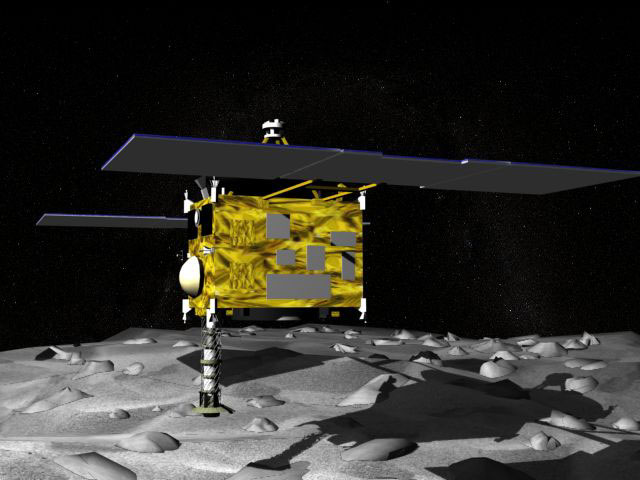Asteroid Probe Ready For Touch and Go Sampling Duties

Japan's Hayabusa spacecraft is on track to attempt a first-of-its-kind sampling of asteroid Itokawa. Ground controllers on Saturday commanded the spacecraft to start a slow descent toward the space rock.
If all goes well, Hayabusa's asteroid sampling device -- a horn-shaped tube -- will gently make contact with the object. During the brief encounter, the space probe will fire a small metal ball at the space rock's surface at very high speed.
The irregularly-shaped Itokawa is a small asteroid, measuring just 1,800 feet long (549 meters) by 590 feet (180 meters) wide.
Fragments of the asteroid caused by the ball's impact are to be snagged within a canister attached at the top of the horn. The first attempt at sample-gathering Sunday (Japan Standard Time) would also release a target marker carrying signatures.
After its brief touchdown, Hayabusa would then retreat to a higher altitude above Itokawa. Another sampling maneuver is slated for November 25.
Multi-task spacecraft
The challenging mission of Hayabusa is being carried out nearly 180 million miles (288,923,070 kilometers) away from Earth.
Breaking space news, the latest updates on rocket launches, skywatching events and more!
In performing its science duties, not all has gone smoothly for Hayabusa.
Ground controllers have developed patchwork control plans due to hardware problems with the multi-task spacecraft. And on November 12, a tiny robot lander was released by Hayabusa that was intended to hop about on the asteroid. The ultra-small device was released too high above Itokawa and did not reach the space rock - drifting off into free space.
Once asteroid specimens are onboard, stashed away in different parts of an onboard container, Hayabusa would propel away from Itokawa by early December. The probe is due to return to Earth in June 2007.
The capsule that holds the samples collected from Itokawa would detach from Hayabusa at a distance from Earth equal to half the distance to the Moon, and plunge into Earth's atmosphere. The sample-carrying canister is set to parachute into a desert landing locale in Woomera, Australia.
Hayabusa was rocketed into space from Japan's Kagoshima Space Center on May 9, 2003. The spacecraft arrived at asteroid Itokawa on September 12 of this year.
- Unbowed by Robot Loss, Japan's Asteroid Probe Readies For Touchdown
- Japanese Asteroid Probe Apparently Lost in Space
- Japanese Asteroid Probe Deploys Micro-Robot
- Japan's Asteroid Probe Cleared For Landing Attempt

Leonard David is an award-winning space journalist who has been reporting on space activities for more than 50 years. Currently writing as Space.com's Space Insider Columnist among his other projects, Leonard has authored numerous books on space exploration, Mars missions and more, with his latest being "Moon Rush: The New Space Race" published in 2019 by National Geographic. He also wrote "Mars: Our Future on the Red Planet" released in 2016 by National Geographic. Leonard has served as a correspondent for SpaceNews, Scientific American and Aerospace America for the AIAA. He has received many awards, including the first Ordway Award for Sustained Excellence in Spaceflight History in 2015 at the AAS Wernher von Braun Memorial Symposium. You can find out Leonard's latest project at his website and on Twitter.
